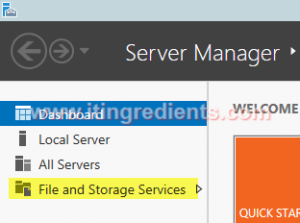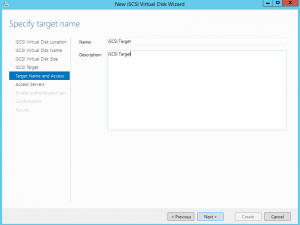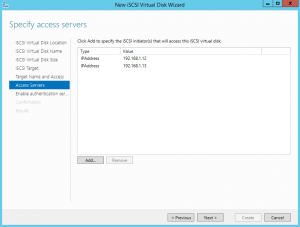How to configure iSCSI Target Server on Windows Server 2012 R2
How to configure iSCSI Target Server on Windows Server 2012 R2
In this post, we’ll learn the steps to configure iSCSI Target Server on Windows Server 2012 R2. In the last post, we learned the steps to install iSCSI Target server on Windows Server 2012 R2.
Steps to configure iSCSI Target Server on Windows Server 2012 R2
Step 1:
Open Server Manager by either clicking on the Server Manager icon next to start button or click on Start button and start typing Server Manager.
On the Server Manager window select “File and Storage Services”.
Step 2:
Select iSCSI
Click on “To create an iSCSI virtual disk, start the new iSCSI Virtual Disk wizard”.
Step 3:
On the “Select iSCSI virtual disk location” window select the Server on which iSCSI Target Server role is installed and then select the volume on which you want to create the storage.
In this practical we have two volumes i.e. C drive and E drive. We’ll select E drive to save the storage. However we can also select the custom path to save the file.
Click on next to continue.
Step 4:
On the “Specify iSCSI virtual disk name” window type the name and description.
We have assigned Vol1 as the name.
Step 5:
On the “Specify iSCSI virtual disk size” window we can see total free Space available. In this practical our E drive was of 200 GB therefore we can see 200 GB as free space.
Define the size of storage that you want to create, we are assigning 100 GB of space.
Select “Dynamically expanding”. It provides better use of physical storage space and is recommended for servers running applications that are not disk intensive.
Click on next to continue.
Step 6:
On the “Assign iSCSI Target” console we can define new iSCSI target however we can use existing iSCSI target if already used.
Step 7:
Specify the target name and description.
Step 8:
Specify the iSCSI initiator that would access the iSCSI virtual disk.
Click on Add to define the initiator.
Step 9:
We can see three methods to identify the initiator
a) Either we can query initiator computer for ID but it is not supported for Windows Server 2008 R2, Windows 7 or earlier Operating systems.
b) Select the initiator cache on the target server.
c) Enter the value for the selected server. We can define IQN, DNS Name, IP Address or MAC Address. In this practical, we’ll define IP Address of the initiator servers.
Step 10:
You can add list of all the initiator servers that would access the iSCSI disk.
Click on next to continue.
Step 11:
You can also enable authentication however it is optional. You can enable CHAP protocol or reverse CHAP to allow initiator to authenticate the iSCSI target however in this practical we are not allowing them.
Click on next to continue.
Step 12:
You can confirm all the settings that you have defined. If all the settings are correct then click on create else click on previous and make the changes.
Step 13:
Once the iSCSI virtual disk and iSCSI target is created successfully you can close the wizard.
Step 14:
Again go to Server Manager select “File and Storage Services” and select iSCSI, if you see newly created disk then it confirms that disk is created successfully.
Hope you understood all the steps to configure iSCSI Target Server on Windows Server 2012 R2. Feel free to leave your comments and suggestions in the comment section.















